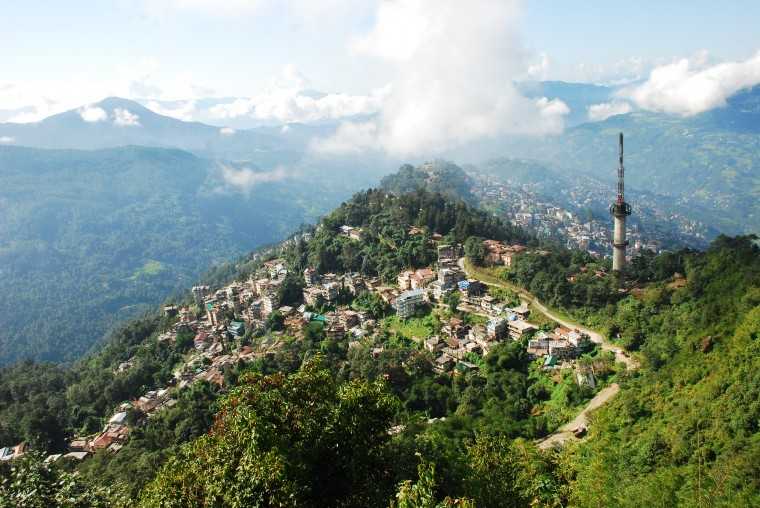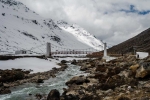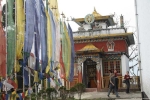Gangtok Tourism
Hills Valleys, Rivers Lakes, Hill Stations, Honeymoon,
Ideal Duration : 2-4 days
Best Time : Throughout the Year
"The Gateway to Sikkim"
Gangtok Tourism
Extremely alluring, pleasantly boisterous and wreathed in clouds - Gangtok, the capital city of the Sikkim can also give you a spectacular view of Mt. Kanchenjunga, at a distant skyline. The pristine hill station nestled in mountains and clouds is also a base for a whole lot of trekkers to the Himalayan mountain ranges. The mesmerising prismatic beauty and the beautiful winding hill roads are even more breathtaking if seen from a bird?s eye view in a cable car.
The name meaning hill-top, Gangtok can be safely said to be one of the most beautiful hill stations in the country. With everything in just the right amount from a blend of cultural identities to urbanisation, Gangtok is a breathing and dynamic bit of paradise of the northeast. It has an amazing view of mount Kanchenjunga, the third highest mountain peak in the world. Also like everything around it, Gangtok is abundant in natural beauty and has various natural attractions such as the Tsomgo Lake, Ban Jhakri falls, Tashi viewpoint and more. Other places to visit include theEnchey Monastery,Ganesh Tok, Do Drul ChortenRumtek Monastery, etc. Also, river Teesta is one of the best spots for white water rafting in North East India.
Download Gangtok PDF Guide >
What's Great?
The capital of Sikkim and base for exploring other parts of Sikkim. One of the cleanest places in India. Availability of good food and music in pubs and restaurants. Good weather with spectacular views all around. Culture and heritage. Pilgrim site for Buddhists.
What's not so Great?
Slightly difficult to access as the nearest airport and railway station are around 4 hours away.
For Whom
Newly-wed couples, trekking enthusiasts, people seeking a break from city life, nature lovers.
Nathula Pass- Indo-China Border
This is one place you just cannot miss if you visit Gangtok. This international Indo-China border requires you to have a permit which can be obtained easily in Gangtok. However, only Indian tourists are allowed till this point, foreigners are not allowed. The border is such that you can actually see the Chinese soldiers as well as the trucks passing from India to China or the other way round. On the way to the border, you can have a good glance at Tsongmo lake on the way. There's another temple on the way which is considered to be very holy by the locals. To reach this point, shared cabs and private cabs are easily accessible from taxi stand in Gangtok.
History
Much like the rest of Sikkim, not much is known about the history of the town. It remained a small boondock until after the construction of Enchey Monastery of Buddhist teachings in 1840 which made it a pilgrimage centre. It became a prominent town after the British invasion and then became the centre for trade between Tibet and British India. Most of the roads were built during this time, the infrastructure was improved, and the telegraph system was modified.
Following India?s independence in 1947. Gangtok remained an independent monarchy, and a treaty was signed between King Chogyal and the then Prime Minister of India- Jawaharlal Nehru, to follow the monarch rule. The state and its capital did not follow the democratic rule.
Finally in 1975, after decades of political uncertainties, struggles and riots, the monarchy was abrogated, and Sikkim became the twenty-second state of India with Gangtok as its official capital.
Shopping In Gangtok
The exotic hill station also has numerous souvenir shops for tourists and the locals. Few of the most important things you should take back from here are-
Canvas paintings and wall hangings give you a taste of the traditional day Gangtok and is sure to make your living room extremely appealing like a chunk from one of the travel magazines.
Gangtok is famous for handicrafts and Tibetan carpets which reflect the arts and culture of the city. Hand-woven jackets are extremely exquisite and pretty and a must-have souvenir.
Sikkim is popular worldwide for its most delicious tea. You can try a couple of varieties of ?Sikkim Tea? from any of the local stores.
Black cardamom is exclusively farmed here and is famous for making any dish aromatic and better tasting.
Hand carved wooden tables are another popular work of the city.
The locally produced wine and hard liquor is of premium quality. You must take a bottle or two of Wine for your next hang-out with friends.
The best places for shoppers are MC Marg for dress material, trinkets, shoes, souvenirs etc. with traditional Sikkimese designs. You can also get books on Buddhism, porcelain cups and other gifting items. The Tibet Road has a line of shops and emporiums for handicrafts and handloom products. There is also Lal Bazaar famous for all kinds of everyday things like cheese, incense sticks and electronic gadgets.
Riding In Cable Car
One of the most significant attractions of Gangtok is the Ropeway- a to and fro cable car ride. It gives you a bird?s eye view of the entire Gangtok township. Each ride can carry upto 24 passengers and has three stations in the 1 km ride. The boarding point is Deorali, the next stop being Namnang and the destination- Tashiling. You can stop at any of these but it is advisable to take a ride back. Gangtok Ropeway operates between 8 AM to 4:30 PM every day. The ticket price is INR 60 for adults and INR 30 for kids below 6 years. Camera charges are additional.
Culture
Gangtok is inhabited by people from different ethnicities including Nepalese, Bhutias, and Lepchas. These various religious groups and communities keep the traditional culture and identity of the city alive. Buddhism and Hinduism are the two majorly followed religion. Gangtok has several monasteries and religious institutions. Different festivals celebrated in Gangtok are a mark of the rich cultural heritage. Other than Diwali, Holi and Christmas; Saga Dawa is a famous Buddhist festival. There is also Phang Lhabsol, celebrated in the honour of Mount Kanchenjunga among other religious festivals. Annual Gangtok Food and Cultural Festival is also organised by the government every year. Music is a much- loved form of entertainment in Gangtok. The Sikkimese cuisine is served in local restaurants which include momos, thukpas, noodles etc.
Nightlife in Gangtok
Apart from the venturesome activities to the tranquil atmosphere, shopping paradises to finger licking food, nightlife in Gangtok is something you can call as an icing on the cake. Exploring Gangtok under the stars is an amazing and the safest experience.
Read more aboutNightlife in Gangtok
Itinerary
Day 1:Reach by afternoon or evening, settle into your room and relax. Enjoy the scenic beauty around you. Take a stroll on the M.G. Road and enjoy some shopping and local dishes. Have a good evening sitting in a pub or a restaurant with some music going on.
Day 2:Have some delightful breakfast and start your city tour. Visit Hanuman Tok, Rumtek Monastery, Namgyal Institute of Tibetology. Have lunch in the main market and experience the Ropeway. In the evening, enjoy some shopping in the local markets. Also, don't forget to obtain a pass to visit the Nathula Pass the next day.
Day 3:You will find a number of taxis available to take you up to Nathula Pass, but it is always better to book one in advance. Visit the Baba Harbhajan Singh Memorial Temple and go to Nathula Pass. You can also enjoy some Yak rides there. You can have a small stopover at Tsongmo lake on the way. Return to Gangtok and spend some time in the Flower Exhibition Centre. Spend the evening at the M.G Marg for some shopping.
Day 4:Have your breakfast and leave for Bagdogra/ New Jalpaiguri for your Flight/ Train. On the way, you can enjoy the white-water rafting at Teesta. Make sure you choose the Train/ Flight timings carefully.
Throughout the yearis the best time to visit Gangtok
Gangtok can be visited all throughout the year, however, the temperature in December-February can go below freezing point while summers have an ideal weather. Being a hilly region, you never have to worry about it being too hot. The only season you have to be careful about is the monsoon when there could be heavy landslides and hence travelling to Gangtok should be avoided.
Weather in Gangtok
Loading...
Gangtok in Spring (March-April)
It is spring time in Gangtok and probably one of the best time to visit. The weather is cold but the skies are clear, giving you a panoramic view of the mountain ranges. This is also the best period to indulge in the adventure activities.
Gangtok in Summer (May-June)
Summer season, the weather is relatively warmer. This is when the tourist season is at the peak because of the summer vacations, so it can get a little crowded. This is also a good time if you wish to explore North and West parts of Sikkim which are relatively colder and can be visited for only limited months in summer.
Gangtok in Monsoon (July-September)
Monsoon is not a good time to visit Gangtok. Because of frequent landslides during monsoon, you need to be a little careful. Stay updated with news if you are planning to visit Gangtok during monsoon. Also, rains make it a little difficult to roam around the city and weather gets very cold while it rains.
Gangtok in Winter (October-February)
The winter season, it is pleasant in the beginning i.e. October and November. It is cold, but the temperature stays above 3-4 degree celsius on most days. The surrounding area looks prettier because of the snow-capped mountains. Towards December and January, the weather gets extremely cold and temperature drops below 0-degree celsius. If you like winter, then this season is perfect for you.
Monthly Weather in Gangtok
Month
Avg. Minimum (°C)
Avg. Maximum (°C)
January
-1
15
February
-0
15
March
5
17
April
10
20
May
12
23
June
10
27
July
12
26
August
13
30
September
12
25
October
7
27
November
1
20
December
0
17
Events in Gangtok
International Flower Festival, Governor'S Residence, Gangtok
1st - 31st May
The International Flower Show is held in Gangtok every year. Several beautiful species of flowers are showcased here, such as orchids, gladioli, roses, cacti, alpine plants, creepers, climbers, ferns, herbs etc. Also, lectures and seminars are held in which renowned botanical scientists come over to speak. The Flower Show is also accompanied with a food festival, where one may try several local delicacies.
Saga Dawa
29th May
Saga Dawa is considered the holiest festival by the Mahayana Buddhists, and is celebrated by lighting lamps in this serene monastery.
Comments on Gangtok
Post Your Comment


 MG Road
MG Road Nathu La Pass
Nathu La Pass Rumtek Monastery
Rumtek Monastery Ganesh Tok
Ganesh Tok Darjeeling
Darjeeling North Sikkim
North Sikkim Kalimpong
Kalimpong South Sikkim
South Sikkim West Sikkim
West Sikkim Aritar
Aritar